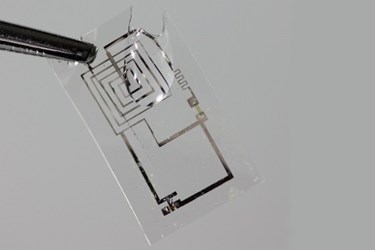Bioresorbable Electronic Implant Made From Silk Combats Bacterial Infections

Tufts University researchers have developed an electronic implant made from silk and magnesium that can be wireless triggered from outside the body to fight bacterial infections. Because it is made of materials that are both biocompatible and dissolvable, the implant harmlessly degrades once it has completed its function.
The device is designed to eliminate infection either by delivering heat or releasing medication. A magnesium power-receiving coil and resistor are deposited on a silk film and wrapped in a silk pocket. By adjusting the crystallinity of the silk, developers can control how much time the implant takes to dissolve, reports IEEE Spectrum.
The device would be implanted during surgery and triggered at the first sign of bacterial infection. Then, once it had done its job, the implant would degrade on a predetermined time schedule. Time of degradation could range anywhere from minutes to weeks, and no surgical retrieval of the device is required.
The research team of Fiorenzo Omenetto, a bioengineering professor at Tufts University, and contributors from the Shanghai Institute of Microsystem and Information Technology and the University of Illinois at Urbana-Champaign collaborated on the design. The researchers presented their preliminary findings at the recent IEEE MEMS 2015 conference in Portugal and published them in Proceedings of the National Academy of Sciences.
In his MEMS 2015 presentation, Omenetto described the implant as a “little band-aid that you put under the skin.” He explained, “Silk here acts like a plastic substrate, and it is medically digestive. And the magnesium on top hydrolyzes and breaks down and dissolves.”
The researchers implanted the device in mice infected with Staphylococcus aureus (S. aureus) bacteria. Using a transmitter, they gave the mice two 10-minute heat treatments that eliminated the infection completely. In a separate experiment, they loaded the pocket with antibiotics that were released when the implant heated up. The device dissolved in 15 days.
Omenetto has spent years researching the biomedical potential of the silkworm. He has worked on designing similar implantable devices since 2012, but this most recent is the first to use magnesium. The previous designs used silicon as the electronics substrate.
Last year, Omenetto presented results of a study using a graphene nanosensor printed on water-soluble silk that could be tattooed onto teeth and used to detect bacteria.
Another research team at Tufts is collaborating with Beth Israel Deaconess Medical Center to take advantage of silk-based technology. A study published in Nature Communications described silk’s benefit over metal pins in repairing bone fractures.
According to the study, “Silk-based devices offer numerous advantages including ease of implantation, conformal fit to the repair site, sterilization by autoclaving and minimal inflammatory response.”
Image credit: Beckman Institute, University of Illinois, and Tufts University
